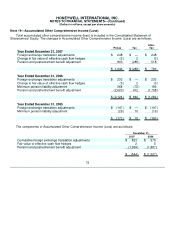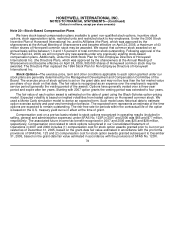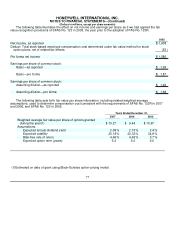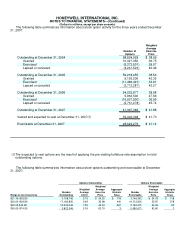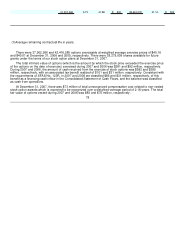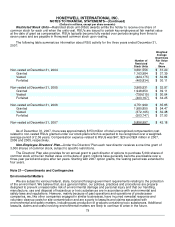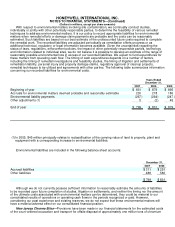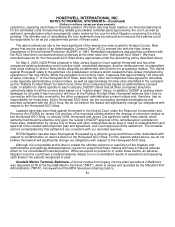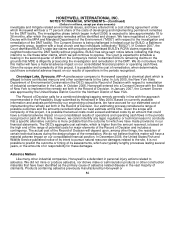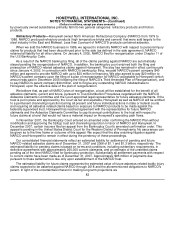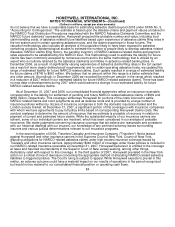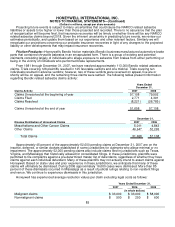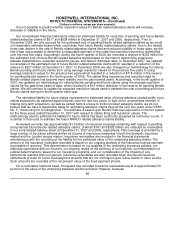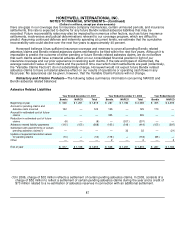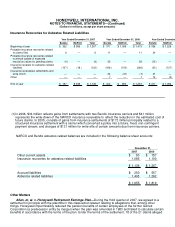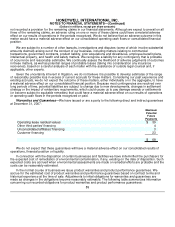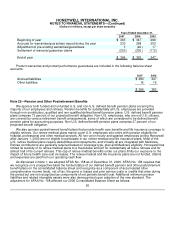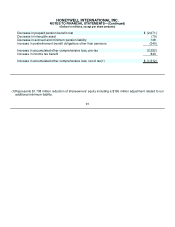Honeywell 2007 Annual Report Download - page 119
Download and view the complete annual report
Please find page 119 of the 2007 Honeywell annual report below. You can navigate through the pages in the report by either clicking on the pages listed below, or by using the keyword search tool below to find specific information within the annual report.
HONEYWELL INTERNATIONAL INC.
NOTES TO FINANCIAL STATEMENTS—(Continued)
(Dollars in millions, except per share amounts)
investigate and mitigate related environmental issues, and have entered into a cost sharing agreement under
which Honeywell will bear a 77 percent share of the costs of developing and implementing permanent remedies
for the DMT facility. The investigative phase (which began in April 2006) is expected to take approximately 18 to
36 months, after which the appropriate remedies will be identified and chosen. We have negotiated a Consent
Decree with the MPA and Maryland Department of the Environment ("MDE") with respect to the investigation and
remediation of the DMT facility. The Consent Decree is being challenged in federal court by BUILD, a Baltimore
community group, together with a local church and two individuals (collectively "BUILD"). In October 2007, the
Court dismissed BUILD's state law claims with prejudice and dismissed BUILD's RCRA claims regarding
neighborhoods near the DMT facility without prejudice. BUILD has since sent notice letters indicating that they
intend to re- file these latter claims, which we will continue to oppose. The Court is expected to schedule a
hearing in the second quarter of 2008 on the Company's motion to dismiss BUILD's remaining claims on the
grounds that MDE is diligently prosecuting the investigation and remediation of the DMT. We do not believe that
this matter will have a material adverse impact on our consolidated financial position or operating cash flows.
Given the scope and complexity of this project, it is possible that the cost of remediation, when determinable,
could have a material adverse impact on our results of operations in the periods recognized.
Onondaga Lake, Syracuse, NY—A predecessor company to Honeywell operated a chemical plant which is
alleged to have contributed mercury and other contaminants to the Lake. In July 2005, the New York State
Department of Environmental Conservation (the DEC) issued its Record of Decision with respect to remediation
of industrial contamination in the Lake. In October 2006, Honeywell entered into a Consent Decree with the State
of New York to implement the remedy set forth in the Record of Decision. In January 2007, the Consent Decree
was approved by the United States District Court for the Northern District of New York.
The Record of Decision calls for a combined dredging/capping remedy generally in line with the approach
recommended in the Feasibility Study submitted by Honeywell in May 2004. Based on currently available
information and analysis performed by our engineering consultants, we have accrued for our estimated cost of
implementing the remedy set forth in the Record of Decision. Our estimating process considered a range of
possible outcomes and the amounts recorded reflect our best estimate at this time. Given the scope and
complexity of this project, it is possible that actual costs could exceed estimated costs by an amount that could
have a material adverse impact on our consolidated results of operations and operating cash flows in the periods
recognized or paid. At this time, however, we cannot identify any legal, regulatory or technical reason to conclude
that a specific alternative outcome is more probable than the outcome for which we have made provisions in our
financial statements. The DEC's aggregate cost estimate, which is higher than the amount reserved, is based on
the high end of the range of potential costs for major elements of the Record of Decision and includes a
contingency. The actual cost of the Record of Decision will depend upon, among other things, the resolution of
certain technical issues during the design phase of the remediation. We do not believe that this matter will have a
material adverse impact on our consolidated financial position. In December 2006, the United States Fish and
Wildlife Service published notice of its intent to pursue natural resource damages related to the site. It is not
possible to predict the outcome or timing of its assessments, which are typically lengthy processes lasting several
years, or the amounts of or responsibility for these damages.
Asbestos Matters
Like many other industrial companies, Honeywell is a defendant in personal injury actions related to
asbestos. We did not mine or produce asbestos, nor did we make or sell insulation products or other construction
materials that have been identified as the primary cause of asbestos related disease in the vast majority of
claimants. Products containing asbestos previously manufactured by Honeywell or
82


